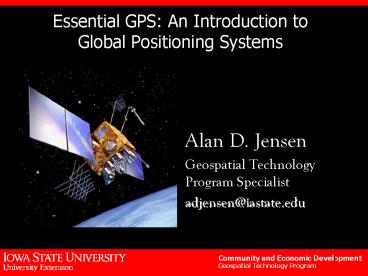Essential GPS: An Introduction to Global Positioning Systems
1 / 12
Title:
Essential GPS: An Introduction to Global Positioning Systems
Description:
Essential GPS: An Introduction to Global Positioning Systems. Alan D. Jensen ... There are 3 Segments to the GPS System. Space segment - Satellites ... –
Number of Views:131
Avg rating:3.0/5.0
Title: Essential GPS: An Introduction to Global Positioning Systems
1
Essential GPS An Introduction to Global
Positioning Systems
- Alan D. Jensen
- Geospatial Technology Program Specialist
- adjensen_at_iastate.edu
2
What is GPS?
- GPS stands for Global Positioning System.
- Initially developed for military purposes in
1978.
3
GPS Consists of
- 24 satellites orbiting 11,000 nautical miles
(20,200km) in - 6 orbital planes above the Earth,
- with 4 satellites in each plane
- and 3 satellites in reserve,
- broadcasting a continuous signal to ground
stations located around the world that control
the satellites, and, - a signal that can be detected by anyone with
- a GPS Receiver that can then determine your
location with great accuracy.
4
There are 3 Segments to the GPS System
- Space segment - Satellites
- Control segment - Ground station
- User segment - Receiver
5
1. The GPS Satellites
- First ten satellites were developmental, called
Block I - 23 production satellites launched between 1989
and 1993, called Block II - 24th satellite launched in 1994 to complete the
system - 12 Hours to orbit the Earth
6
2. The Control Segment
- Synchronize Satellite and Receiver Clocks
- Measure Travel Time of Satellite Signal, t
- Distance (r) Speed of Light(c) t
Satellites are equipped with very precise clocks
that keep accurate time - to within three
nanoseconds
7
2. The Control Segment
- There are 5 control stations that monitor the
satellites. - Control stations enable information on Earth to
be transmitted to the satellites. - Control stations continually track satellites,
and update the positions of each satellite. - Without control stations the accuracy of the
system would degrade in a matter of days.
8
3. The GPS Receiver
- GPS units are referred to as receivers. They
receive radio signals from satellites. - Prices range from 100 -10,000 plus
- Accuracy 10 meters to sub-centimeter
- The GPS receiver calculates the amount of time it
takes the signal to travel from the satellite to
the receiver. - So it does the math
- Distance time x velocity
- Distance time x 186,355 mi/sec
- The receiver therefore calculates the distance to
each satellite that is logged into the receiver
from the receive.
Magellan eXplorist 200
Trimble Receiver
Garmin eTrex Legend
9
How GPS Works
- How does the GPS know where you are?
- GPS uses Triangulation
- You can find any point if given distances
- from 3 other points.
10
How GPS Works
- 2-D Triangulation
- Imagine you are somewhere in the United States
and you are TOTALLY lost -- for whatever reason,
you have absolutely no clue where you are. - You find a friendly local and ask, "Where am I?"
He says, "You are 625 miles from Boise, Idaho." - This is a nice, hard fact, but it is not
particularly useful by itself. You could be
anywhere on a circle around Boise that has a
radius of 625 miles, like shown here.
625 mi
Boise
11
How GPS Works
- You ask somebody else where you are, and she
says, "You are 690 miles from Minneapolis,
Minnesota." - Now you're getting somewhere. If you combine this
information with the Boise information, you have
two circles that intersect. - You now know that you must be at one of these two
intersection points, if you are 625 miles from
Boise and 690 miles from Minneapolis.
625 mi
690 mi
Boise
Minneapolis
12
How GPS Works
- If a third person tells you that you are 615
miles from Tucson, Arizona, you can eliminate one
of the possibilities, because the third circle
will only intersect with one of these points. - You now know exactly where you are in --Denver,
Colorado.
625 mi
690 mi
Boise
Minneapolis
Denver
615 mi
Tucson































